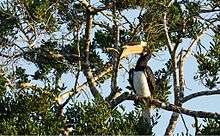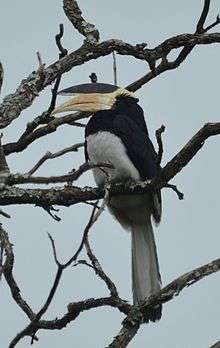Malabar pied hornbill
| Malabar pied hornbill | |
|---|---|
 | |
| Scientific classification | |
| Kingdom: | Animalia |
| Phylum: | Chordata |
| Class: | Aves |
| Order: | Bucerotiformes |
| Family: | Bucerotidae |
| Genus: | Anthracoceros |
| Species: | A. coronatus |
| Binomial name | |
| Anthracoceros coronatus (Boddaert, 1783) | |

The Malabar pied hornbill (Anthracoceros coronatus), also known as lesser pied hornbill, is a bird in the hornbill family,[2] a family of tropical near-passerine birds found in the Old World.
Status and distribution
The Malabar pied hornbill is a common resident breeder in tropical and subtropical Asia from India east to Borneo. Its habitat is evergreen and moist deciduous forests, often near human settlements.
Description
The Malabar pied hornbill is a large hornbill, at 65 cm (26 in) in length. It has mainly black plumage, apart from its white belly, throat patch, tail sides and trailing edge to the wings. The bill is yellow with a large, mainly black casque. Females have white orbital skin, which the males lack. Juveniles have no casque. It might be confused with the oriental pied hornbill.
Natural history
This species is omnivorous, taking fruits, small mammals, birds, small reptiles, insects etc. Prey is killed and swallowed whole. Figs are an important food, contributing 60% of their diet from May to February, the non-breeding season; during breeding, in March and April, up to 75% of the fruits delivered at the nest were figs. They also feed on other fruits, including those of the Strychnos nux-vomica, which are toxic to many vertebrates.[3]
During incubation, the female lays two or three white eggs in a tree hole, which is blocked off with a cement made of mud, droppings and fruit pulp. There is only one narrow aperture, just big enough for the male to transfer food to the mother and chicks. When the chicks have grown too large for the mother to fit in the nest with them, she breaks out and rebuilds the wall, after which both parents feed the chicks.

Great pied hornbills and Malabar pied hornbills are frequently spotted at the township of the Kaiga Atomic Power Station near Karwar. The rich biodiversity in the forest around the plant has become a niche for a wide variety of rare bird species.[4] A study comparing populations over a 23-year period at Dandeli found no significant change.[5]
In central India, tribal peoples believed that hanging a skull of the hornbill (known as dhanchidiya) brought wealth.[6]
Notes
- ↑ BirdLife International (2012). "Anthracoceros coronatus". IUCN Red List of Threatened Species. Version 2013.2. International Union for Conservation of Nature. Retrieved 26 November 2013.
- ↑ Bibliography of Malabar Pied Hornbill - Anthracoceros coronatus
- ↑ Balasubramanian, P.; R. Saravanan and B. Maheswaran (2004). "Fruit preferences of Malabar Pied Hornbill Anthracoceros coronatus in Western Ghats, India". Bird Conservation International 14: pp. 69-79 doi:10.1017/S095927090500024 9
- ↑ http://www.deccanherald.com/content/349338/greens-pour-scorn-kaiga-hornbills.html
- ↑ Sneha V & P Davidar (2011). "Status survey of Malabar Pied Hornbill in the Dandeli region, Northern Western Ghats, India" (PDF). Raffles Bulletin of Zoology. Supplement 24: 45–51.
- ↑ Hislop, Stephen (1866). Papers relating to the Aboriginal tribes of the Central Provinces. Chief Commissioner of the Central Provinces, Nagpur. p. 6.
References
- Birds of India by Grimmett, Inskipp and Inskipp, ISBN 0-691-04910-6
External links
| Wikimedia Commons has media related to Anthracoceros coronatus. |
- Oiseaux Photo
